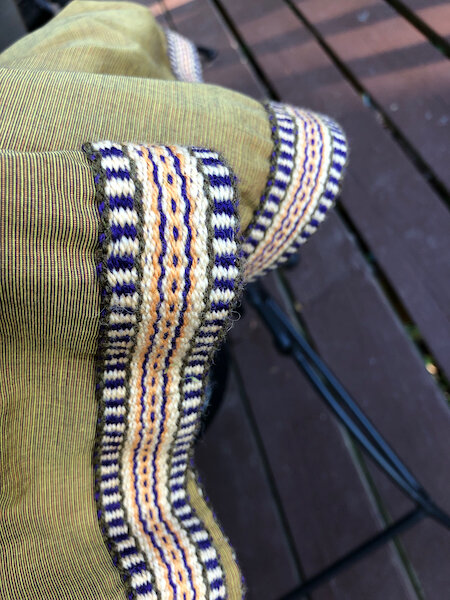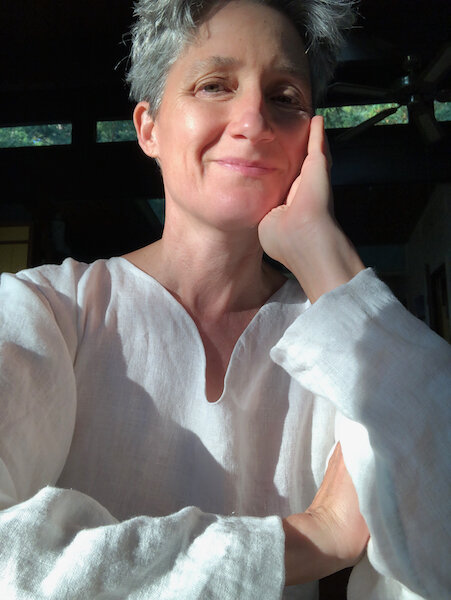I’ve come to accept that I always have a motley collection of intentions, a patchwork of projects, each inching along at its own pace.
Warp-faced strip of two handspun merino/bamboo/silk yarns who have long awaited being woven together to see what happens.
The slow pace can sometimes drain the excitement, so that by the time I share or finish something, it’s already old to me.
Handspun cotton accumulating in the to-be-washed pile.
But maybe the slow pace is the excitement, or the importance of the thing.
Not rushing can be a subversive, significant act.
Linen shift stitching in progress - felling a seam.
Valuing flashes of brilliance over steady accumulation of skill and knowledge is part of the prevailing illness today —- why not glory in taking a long time to slowly make a thing?
Which I do. In several different directions, all at once.
Twisting some fine cordage from long leaves. Love the fineness, but the fingers get tired, and my joins need work.
Closeup of backstrap woven bath mat in progress, with weft of cotton t-shirt strips and carved Allen Berry sword beater.
I wanted to share an update on my 18th century-style petticoat skirt, mentioned at the end of this post. The fabric is so light that the skirt simply crawled up my legs when I walked in it, so something needed to be done. I thought of adding a handwoven hem band, probably getting the idea from Lao skirts and the separate hems they often add to the main skirt fabric. Looking at the photos, I realize now that even when a separate hem is not sewn on, the additional woven decoration at the bottom adds weight (as in the second photo below.)
Lao tube skirt (pha sinh) - the ikat upper part is the main skirt, the brocade weaving below is a separately woven hem section.
These pha sinh are woven in one piece, but the borders are decorated with supplementary (brocade) patterning.
One of my narrow woven wool bands looked good against the skirt fabric, but I wanted the hem band wider. So I scaled up the pattern using my handy Inkle Visualizer app, and wound a warp in the same colors, closer to 2”/5 cm wide. As often happens, I miscalculated length because I don’t have a good sense of takeup percentage (how much length is lost in the weaving), so I ended up with a nice hem band that was about a handspan and a half too short.
Backstrap-woven, handspun wool hem on petticoat.
What to do? Standing in my studio, the stacks of folded fabric catch the eye, and in my life “patchwork” is more than just a metaphor. The solution was obvious.
Patchwork fabric infill, at the back of the skirt hem where the woven band did not reach.
I actually padded the patchwork strip with batting, and put in some quilting stitches along the seams for strength, since the patchwork needed to be equal to warp-faced woven wool. Solving these little problems of durability, weight, and behavior in garments teaches so much about how and why people made clothes in various ways, throughout time and place!
And the tiny bit of quilting sparked something else, the memory of my love for that act, that set of skills and motions. As it happens, I had a fully assembled, partially quilted project handy to get back into the joy of hand quilting. This is a 20-year-old piece with its own story, which I will feature at another time. Suffice to say it has a theme of colonization, refugees, and war, which unfortunately never ceases to be relevant. Meanwhile, I also find it beautiful and highly evocative, with memories of Dharamsala, India, where it began.
Patchwork quilt in hoop and on the floor below, big basting stitches and quilting stitches shown in the hoop.
Hand quilting in progress, red thread on cotton and Tibetan silk fabric patches.
Even these photos are already a few months old, because I somehow got distracted from working on this, as well….. As I said, it’s a constant, swirling dance of discovery, my inching along with each project as the mood strikes. But the stitching here may have fed into the stitching on the linen shift, which is nearing completion. It’s all moving, deepening and spreading like water filling a dry, rutted patch of earth. Something will grow here, surely.
Self in linen shift, showing finished neckline and cuffs, in nice afternoon light.








